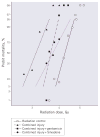Radiation injury after a nuclear detonation: medical consequences and the need for scarce resources allocation
- PMID: 21402810
- PMCID: PMC3643117
- DOI: 10.1001/dmp.2011.17
Radiation injury after a nuclear detonation: medical consequences and the need for scarce resources allocation
Abstract
A 10-kiloton (kT) nuclear detonation within a US city could expose hundreds of thousands of people to radiation. The Scarce Resources for a Nuclear Detonation Project was undertaken to guide community planning and response in the aftermath of a nuclear detonation, when demand will greatly exceed available resources. This article reviews the pertinent literature on radiation injuries from human exposures and animal models to provide a foundation for the triage and management approaches outlined in this special issue. Whole-body doses >2 Gy can produce clinically significant acute radiation syndrome (ARS), which classically involves the hematologic, gastrointestinal, cutaneous, and cardiovascular/central nervous systems. The severity and presentation of ARS are affected by several factors, including radiation dose and dose rate, interindividual variability in radiation response, type of radiation (eg, gamma alone, gamma plus neutrons), partial-body shielding, and possibly age, sex, and certain preexisting medical conditions. The combination of radiation with trauma, burns, or both (ie, combined injury) confers a worse prognosis than the same dose of radiation alone. Supportive care measures, including fluid support, antibiotics, and possibly myeloid cytokines (eg, granulocyte colony-stimulating factor), can improve the prognosis for some irradiated casualties. Finally, expert guidance and surge capacity for casualties with ARS are available from the Radiation Emergency Medical Management Web site and the Radiation Injury Treatment Network.
Figures





Similar articles
-
Allocation of scarce resources after a nuclear detonation: setting the context.Disaster Med Public Health Prep. 2011 Mar;5 Suppl 1:S20-31. doi: 10.1001/dmp.2011.25. Disaster Med Public Health Prep. 2011. PMID: 21402809
-
Scarce resources for nuclear detonation: project overview and challenges.Disaster Med Public Health Prep. 2011 Mar;5 Suppl 1:S13-9. doi: 10.1001/dmp.2011.15. Disaster Med Public Health Prep. 2011. PMID: 21402805 No abstract available.
-
Using the model of resource and time-based triage (MORTT) to guide scarce resource allocation in the aftermath of a nuclear detonation.Disaster Med Public Health Prep. 2011 Mar;5 Suppl 1:S98-110. doi: 10.1001/dmp.2011.16. Disaster Med Public Health Prep. 2011. PMID: 21402818
-
Radiation Injury, Burns and Illness: A Review of Best Practices. Your approach should include identifying sources, determining exposure and managing resources.EMS World. 2016 Oct;45(10):52-59. EMS World. 2016. PMID: 29953758 Review. No abstract available.
-
Cutaneous and local radiation injuries.J Radiol Prot. 2022 Jan 12;42(1):10.1088/1361-6498/ac241a. doi: 10.1088/1361-6498/ac241a. J Radiol Prot. 2022. PMID: 34488201 Free PMC article. Review.
Cited by
-
Model for Evaluating Antimicrobial Therapy To Prevent Life-Threatening Bacterial Infections following Exposure to a Medically Significant Radiation Dose.Antimicrob Agents Chemother. 2022 Oct 18;66(10):e0054622. doi: 10.1128/aac.00546-22. Epub 2022 Sep 26. Antimicrob Agents Chemother. 2022. PMID: 36154387 Free PMC article.
-
In-plane Extended Nano-coulter Counter (XnCC) for the Label-free Electrical Detection of Biological Particles.Electroanalysis. 2022 Dec;34(12):1961-1975. doi: 10.1002/elan.202200091. Epub 2022 Jun 14. Electroanalysis. 2022. PMID: 37539083 Free PMC article.
-
United States medical preparedness for nuclear and radiological emergencies.J Radiol Prot. 2021 Dec 6;41(4):10.1088/1361-6498/ac0d3f. doi: 10.1088/1361-6498/ac0d3f. J Radiol Prot. 2021. PMID: 34153947 Free PMC article.
-
Radiation-induced multi-organ injury.Int J Radiat Biol. 2024;100(3):486-504. doi: 10.1080/09553002.2023.2295298. Epub 2024 Jan 2. Int J Radiat Biol. 2024. PMID: 38166195 Free PMC article.
-
An Exploration of Molecular Correlates Relevant to Radiation Combined Skin-Burn Trauma.PLoS One. 2015 Aug 6;10(8):e0134827. doi: 10.1371/journal.pone.0134827. eCollection 2015. PLoS One. 2015. PMID: 26247844 Free PMC article.
References
-
- Knebel AR, Coleman CN, Cliffer KD, et al. Allocation of scarce resources after a nuclear detonation: setting the context. Disaster Med Public Health Prep. 2011;5(Suppl 1):S20–S31. - PubMed
-
- Coleman CN, Weinstock DM, Casagrande R, et al. Triage and treatment tools for use in a scarce resources-crisis standards of care setting after a nuclear detonation. Disaster Med Public Health Prep. 2011;5(Suppl 1):S111–S121. - PubMed
-
- Hick JL, Weinstock DM, Coleman CN, et al. Healthcare system planning for and response to a nuclear detonation. Disaster Med Public Health Prep. 2011;5(Suppl 1):S73–S88. - PubMed
-
- Murrain-Hill P, Coleman CN, Hick JL, et al. Medical response to a nuclear detonation: creating a playbook for state and local planners and responders. Disaster Med Public Health Prep. 2011;5(Suppl 1):S89–S97. - PubMed
-
- Federal Emergency Management Agency, US Department of Homeland Security. [Accessed December 2, 2010.];FEMA fact sheet: National Planning Scenarios. 2009 http://www.fema.gov/pdf/media/factsheets/2009/npd_natl_plan_scenario.pdf. Published 2009.
Publication types
MeSH terms
Grants and funding
LinkOut - more resources
Full Text Sources
Other Literature Sources
Medical

